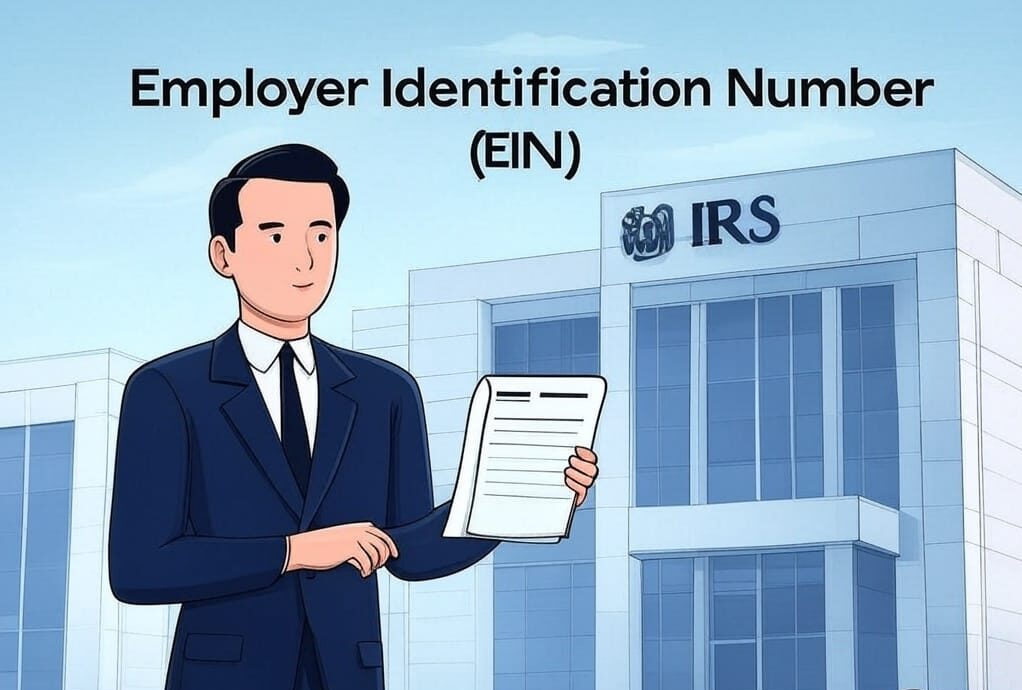
Running a small business? Payroll is the backbone of your team’s trust—and one IRS mistake can cost you $1,000+ per employee in penalties. But don’t panic! We’ll walk you through setting up payroll flawlessly, even if you’re a first-timer.
Key Takeaways
- Obtain an Employer Identification Number (EIN) first.
- Classify workers correctly: W-2 employees vs. 1099 contractors.
- Automate with payroll software (costs $20–$100/month) to avoid tax errors.
- Stay compliant with federal, state, and local tax filings.
- 92% of small businesses using payroll software reduce errors by 50%+ (Source: Deloitte).
Step 1: Get Your Employer Paperwork in Order
A. Obtain an Employer Identification Number (EIN)

What It Is:
An EIN is a unique 9-digit tax ID for your business, required to hire employees, open a business bank account, and file taxes.
How to Apply:
- Online: Visit the IRS EIN Assistant.
- Complete the interview-style form (15–20 minutes).
- Receive your EIN immediately via PDF.
- By Fax/Mail: Submit Form SS-4 (1–2 weeks processing).
Common Pitfalls:
- Sole Proprietors: You can use your SSN, but an EIN protects against identity theft.
- Multiple Businesses: Each LLC or corporation needs a separate EIN.
Example:
Sarah runs a bakery with two locations. She needs separate EINs for her LLC and a new food truck business.
B. Register with State and Local Agencies
State Requirements:
- State Tax ID: Register with your state’s Department of Revenue (e.g., California’s EDD).
- Purpose: Withhold state income tax and pay unemployment insurance (SUTA).
- New Hire Reporting: Submit employee details to your state’s workforce agency within 20 days of hiring.
Local Permits:
- City Business Licenses: Required in cities like Seattle and Phoenix.
- Occupational Taxes: Some counties (e.g., Fulton County, GA) charge annual fees.
Action Steps:
- Use the Small Business Administration (SBA) local tool to find requirements.
- Check county/city websites for specific forms.
Costs:
- State Registration: $50–$300 (one-time).
- Local Permits: $25–$500 annually.
C. Classify Workers Correctly
W-2 Employees vs. 1099 Contractors:
| Factor | W-2 Employee | 1099 Contractor |
|---|---|---|
| Control | Set hours, tools, and methods | Choose how/when to work |
| Taxes | Employer pays 7.65% FICA | Contractor pays 15.3% self-employment tax |
| Benefits | Eligible for health insurance, 401(k) | No benefits required |
IRS Guidelines:
Use the IRS 20-Factor Test to avoid misclassification.
Penalties:
- Federal: 50–50–5,000 per misclassified worker.
- State: California’s AB5 law imposes stricter tests (fines up to $25,000).
Example:
Mike hired a graphic designer to create logos. Since he didn’t control her hours or tools, she’s a 1099 contractor.
Step 2: Collect Employee Documents
1. Form W-4 (Federal Tax Withholding)
2025 Updates:
- New Field: “Multiple Jobs” section for spouses or secondary incomes.
- Tax Credits: Employees can claim dependents or education credits.
How to Fill:
- Step 4(a): Additional income (e.g., freelance work).
- Step 4(b): Extra withholding (e.g., bonuses).
State Equivalents:
- Form W-4 Equivalent:
- California: DE 4
- New York: IT-2104
Storage:
- Keep forms for 4 years post-employment (IRS requirement).
2. Form I-9 (Employment Eligibility)
Documents Accepted:
- List A: Passport, Permanent Resident Card (proves identity + work eligibility).
- List B + C: Driver’s license (B) + Social Security card (C).
Process:
- Employee completes Section 1 by their first day.
- Employer verifies documents and completes Section 2 within 3 days.
Remote Hiring:
- Use authorized reps (e.g., notaries) to inspect documents via video.
Penalties:
- Paperwork Errors: $230–$2,292 per violation.
- Knowingly Hiring Undocumented Workers: Up to $25,000 per employee.
Ensure every employee submits a completed W-4 and I-9 form during the onboarding process to stay compliant.
3. State-Specific Forms
| State | Form | Purpose |
|---|---|---|
| Texas | Form TW-4 | State income tax withholding |
| Pennsylvania | PA REV-419 | Local Earned Income Tax (EIT) |
| Ohio | IT-4 | School district tax withholding |
Action Steps:
- Visit your state’s Department of Revenue website.
- Provide employees with state-specific forms on their first day.
4. Direct Deposit Authorization
Requirements:
- Written Consent: Employees must sign a form authorizing deposits.
- Account Details: Collect routing and account numbers (use encrypted software).
Alternatives:
- Pay Cards: Prepaid cards for unbanked employees (check state laws).
- Paper Checks: Required in states like Rhode Island, which mandates check payment if direct deposit is refused.
Example:
Emily’s café uses Gusto to store encrypted direct deposit details, reducing check-printing costs by 80%.
Step 3: Choose a Payroll Schedule
Federal and State Laws
- Federal Fair Labor Standards Act (FLSA): No federal mandate, but states set rules.
- State Penalties:
- California: Salaried employees must be paid at least twice monthly.
- New York: Manual workers must be paid weekly.
2025 Changes:
- Colorado: New law requires semi-monthly pay for all industries (effective Jan 1, 2025).
Pay Schedule Options
| Schedule | Pros | Cons |
|---|---|---|
| Weekly | Preferred by hourly workers | High processing fees |
| Biweekly | Consistent cash flow (26 pay periods) | Overtime calculations can be complex |
| Semimonthly | Aligns with bills (24 pay periods) | Pay dates vary (e.g., 15th and 30th) |
| Monthly | Low administrative effort | Cash flow strain for employees |
Best Practices:
- Hourly Workers: Weekly or biweekly.
- Salaried Employees: Semimonthly.
Transitioning Schedules:
- Notify employees 30 days in advance (required in CT, CA, and NY).
- Adjust payroll software settings to prorate salaries.
Example:
After switching from monthly to biweekly, Jake’s landscaping business saw a 40% drop in late-time tracking submissions.
Holiday and Weekend Pay Dates
- Weekends: Pay employees the last business day before (e.g., Friday for a Sunday due date).
- Holidays: Process payroll 2–3 days early (banks may delay deposits).
State-Specific Rules:
- Massachusetts: Requires payment within 6 days of the pay period end.
- Texas: No strict deadline, but consistency is legally binding.
Step 4: Calculate Gross Pay and Deductions
A. Hourly Employees
Formula:
Gross Pay = (Regular Hours × Hourly Rate) + (Overtime Hours × 1.5 × Hourly Rate)
Example:
- Employee: Works 45 hours at $20/hour.
- Calculation:
- Regular pay: 40 hours × $20 = $800
- Overtime pay: 5 hours × ($20 × 1.5) = $150
- Total Gross Pay: $950
State Overtime Variations:
- California: Daily overtime (1.5× after 8 hours, 2× after 12 hours).
- Colorado: Overtime after 12 hours/day or 40 hours/week.
Tools:
- Use free calculators like the DOL Overtime Calculator.
B. Salaried Employees
Formula:
Copy
Per-Paycheck Gross Pay = Annual Salary ÷ Number of Pay Periods
Example:
- Annual Salary: $60,000
- Biweekly Pay: $60,000 ÷ 26 = $2,307.69
- Semimonthly Pay: $60,000 ÷ 24 = $2,500
Exempt vs. Nonexempt:
- Exempt: No overtime (must earn ≥ $35,568/year, per 2025 FLSA rules).
- Nonexempt: Eligible for overtime (common for salaried roles under $35,568).
C. Deductions Breakdown
1. Federal Income Tax:
- Use IRS Publication 15-T and the employee’s W-4 to calculate withholding.
- 2025 Tax Brackets:
| Single Filers | Married (Joint) | Tax Rate |
|---|---|---|
| $0 – $11,600 | $0 – $23,200 | 10% |
| $11,601 – $47,150 | $23,201 – $94,300 | 12% |
| $47,151 – $100,525 | $94,301 – $201,050 | 22% |
2. FICA Taxes:
- Employee Pays: 7.65% (6.2% Social Security up to $168,600 wage base + 1.45% Medicare).
- Employer Pays: 7.65% (matching).
3. State/Local Taxes:
- No Income Tax States: TX, FL, NV (but may have other taxes like TX franchise tax).
- High-Tax States: CA (1–13.3%), NY (4–10.9%).
4. Voluntary Deductions:
- Health Insurance: Premiums for employer-sponsored plans.
- Retirement: 401(k) contributions (e.g., employee defers 5% of $2,500 = $125.
Sample Pay Stub:
| Earnings | Amount | Deductions | Amount |
|---|---|---|---|
| Regular Hours (40) | $800.00 | Federal Tax | $89.00 |
| Overtime (5) | $150.00 | State Tax (CA) | $45.00 |
| Total Gross | $950.00 | Medicare | $13.78 |
| 401(k) Contribution | $47.50 | ||
| Net Pay | $754.72 |
Step 5: Choose Payroll Software
Top 2025 Payroll Tools
| Software | Cost | Best For | Key Features |
|---|---|---|---|
| Gusto | $40 + $6/employee | Startups & small teams | Auto-tax filing, health benefits, time tracking |
| QuickBooks | $30 + $5/employee | Businesses using QuickBooks | Seamless accounting sync, project tracking |
| ADP Run | $25 + $5/employee | Scaling businesses (50+ employees) | HR tools, compliance alerts, multicounty tax support |
| Paychex Flex | $39 + $5/employee | Industries with complex labor laws | OSHA reporting, background checks |
Why Automate?
- Avoid Penalties: Software auto-files Forms 941, 940, and W-2s.
- Multi-State Compliance: Handles local taxes in all 50 states (e.g., NY’s Paid Family Leave).
- Employee Self-Service: Workers access pay stubs and W-2s via portals.
Integration Options:
- Time Tracking: TSheets, Homebase.
- Accounting: Xero, FreshBooks.
- Benefits: Zenefits, Rippling.
Step 6: Run Payroll and Distribute Payments
1. Input Data
- Hourly Employees: Upload timesheets (CSV or software-integrated clock-ins).
- Salaried Employees: Verify no changes unless raises/bonuses apply.
2. Review Deductions
- Pre-Tax Deductions: Health insurance, 401(k).
- Post-Tax Deductions: Garnishments, union dues.
3. Approve Payments
- Direct Deposit: Process 2–3 days before payday (banks take 1–2 days to clear).
- Check Printing: Use security features (watermarks, tamper-proof paper).
4. Save Records
- Digital Backup: Use encrypted cloud storage (Dropbox, Google Drive).
- IRS Requirements: Keep payroll records for 4 years, including:
- Timecards
- Pay stubs
- Tax filings
Common Errors:
- Missed Deadlines: Set calendar reminders for paydays and tax due dates.
- Overpaid Employees: Use software to claw back via future paychecks.
Direct deposit is the most efficient way to pay employees securely and ensure timely payments.
Step 7: File Taxes and Reports
Federal Filings
| Form | Purpose | Deadline |
|---|---|---|
| Form 941 | Quarterly federal tax return | Last day of next month (e.g., Jan 31 for Q4) |
| Form 940 | Annual unemployment taxes (FUTA) | January 31 |
| Form W-2 | Employee wage and tax statement | January 31 |
| Form 1099-NEC | Non-employee compensation (contractors) | January 31 |
E-Filing:
- Use the IRS FIRE System for forms 941/940.
- Penalty for late W-2s: 50perform∗∗iffiled≤30dayslate;upto∗∗50perform∗∗iffiled≤30dayslate;upto∗∗290/form after August 1.
State Filings
- SUTA (Unemployment Taxes): Rates vary by state and claims history (e.g., 0.5–6% in TX).
- PA Unemployment: File quarterly via UCMS.
Local Taxes:
- Philadelphia Wage Tax: 3.79% for residents, 3.44% for non-residents (file monthly).
- Denver Occupational Tax: $5.75/month per employee.
Step 8: Stay Compliant
1. Annual Compliance Tasks
- Update Posters: Download free federal/state labor law posters from the DOL.
- Renew EIN: Not required (EINs are permanent).
- Verify Employee Classifications: Audit 1099 contractors annually using IRS guidelines.
2. Tax Rate Updates
- Social Security Wage Base: Increases yearly (2025: $168,600).
- State Unemployment Rates: Check updates via your state’s workforce agency (e.g., NY DOL).
3. Training and Audits
- Staff Training: Use IRS Small Business Tax Workshops.
- Internal Audits: Review 5–10 random pay stubs quarterly for accuracy.
Penalties to Avoid:
- Late Tax Payments: 2% penalty if paid 1–5 days late; up to 15% after 16 days.
- Incorrect W-2s: $290 per form if errors aren’t corrected within 30 days.
Final Checklist for 2025
- ✅ Confirm EIN and state tax IDs are active.
- ✅ Classify all workers correctly (W-2 vs. 1099).
- ✅ Set up payroll software with tax auto-filing.
- ✅ Train staff on timesheet submissions and deadlines.
- ✅ Mark federal/state tax due dates on calendars.
By mastering these steps, you’ll ensure seamless payroll operations, avoid costly fines, and keep your team paid accurately and on time. 🚀
FAQs
How often do I pay payroll taxes?
- Monthly: If taxes withheld are $50,000+/year.
- Semiweekly: If taxes exceed $100,000+/year.
What if I have remote employees in other states?
Register in each state where employees work and comply with local tax laws.

